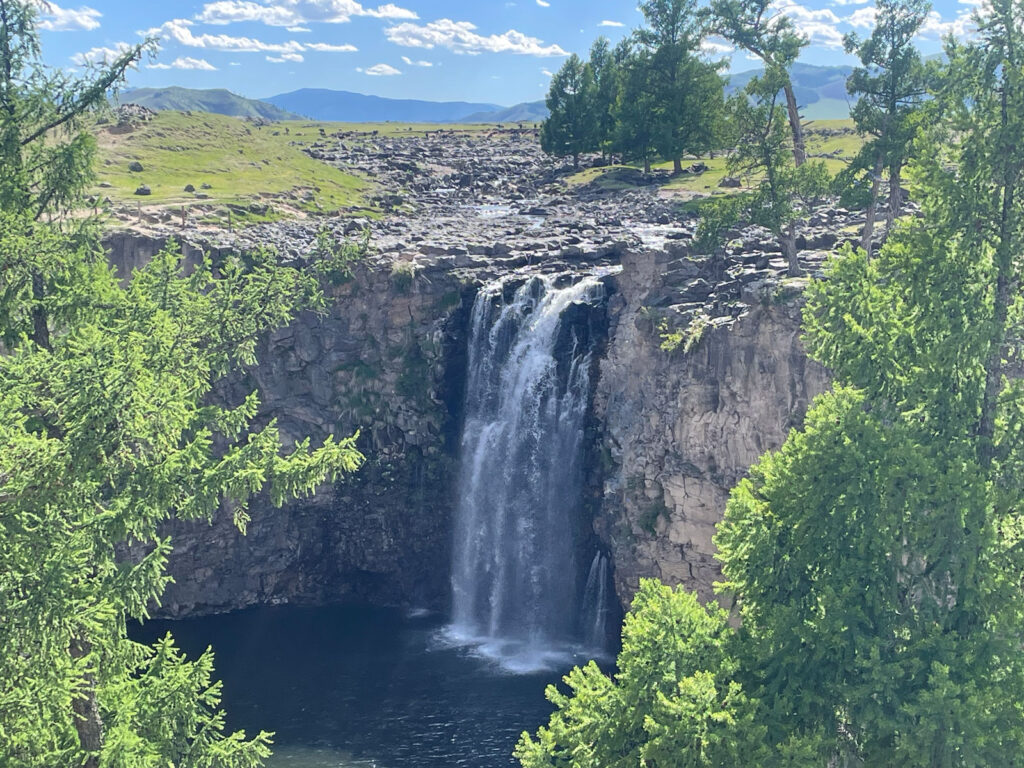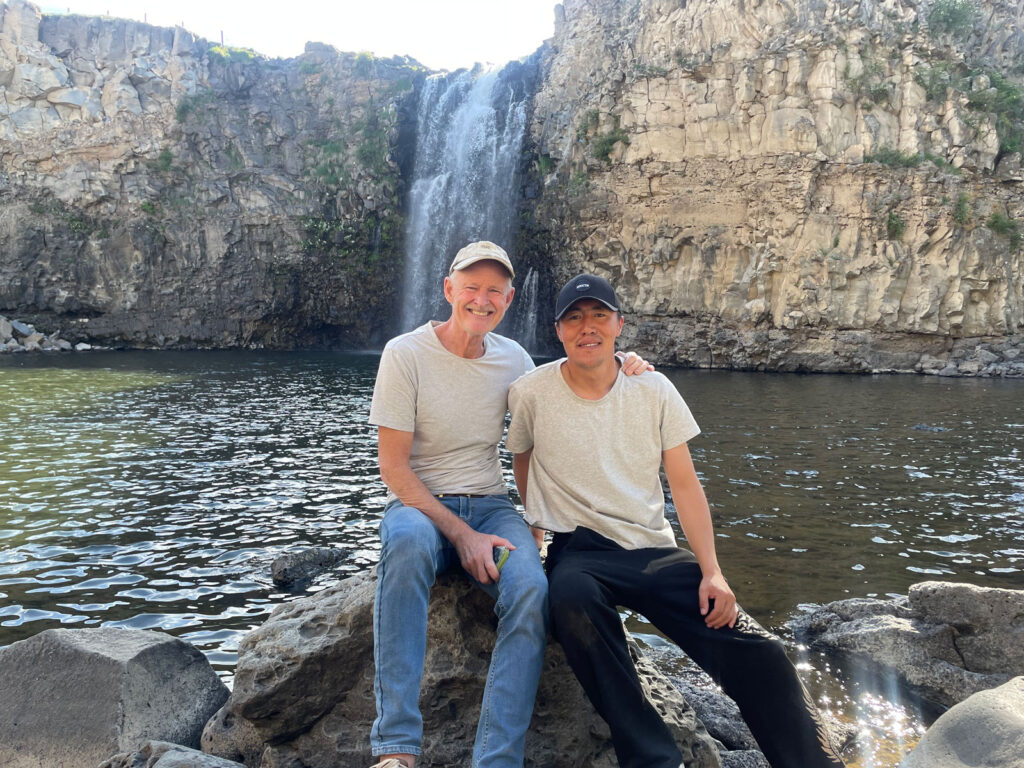Discovering Ulaan Tsutgalan Waterfall: The Majestic Red Waterfall of Uvurkhangai Province
In the heart of Mongolia’s rugged central highlands, Ulaan Tsutgalan Waterfall, often referred to as the “Red Waterfall,” stands as one of the country’s most stunning natural wonders. Located in Uvurkhangai Province, this breathtaking waterfall is a hidden gem that captivates visitors with its striking appearance and serene surroundings. Whether you’re an adventure seeker, a nature lover, or simply looking to experience Mongolia’s natural beauty, Ulaan Tsutgalan offers an unforgettable journey.
The Charm of Ulaan Tsutgalan Waterfall
Geological and Natural Features
Ulaan Tsutgalan Waterfall is renowned for its distinctive reddish hue, which gives it its evocative name, “Red Waterfall.” The waterfall cascades down a rugged cliff face, creating a dramatic and picturesque scene. The red coloration of the rocks is due to the high iron content in the mineral deposits, which reacts with the water and creates a vibrant reddish tint. This unique feature makes Ulaan Tsutgalan a rare and visually striking natural phenomenon.
- Height and Flow: The waterfall plunges approximately 20 meters (65 feet) into a rocky basin below, with the water flowing over a series of steps and ledges. The cascading flow and the surrounding rock formations enhance the waterfall’s grandeur, providing excellent photographic opportunities and a serene environment for visitors.
- Surrounding Landscape: The area surrounding Ulaan Tsutgalan is characterized by a mix of rocky terrain, lush vegetation, and expansive grasslands. The contrasting colors of the red rocks, the verdant greenery, and the clear blue sky create a stunning visual landscape. The serene ambiance is perfect for relaxation, hiking, and exploring the natural beauty of the region.

Getting to Ulaan Tsutgalan
Location and Accessibility
Ulaan Tsutgalan Waterfall is situated in Uvurkhangai Province, approximately 550 kilometers (340 miles) southwest of Ulaanbaatar. The waterfall is accessible by road, though the journey involves traveling through remote and often rugged terrain.
- By Road: The most common way to reach Ulaan Tsutgalan is by road from Ulaanbaatar. The drive typically takes around 10 to 12 hours, depending on road conditions. Travelers can hire a 4×4 vehicle or join an organized tour for a more comfortable journey. The route to the waterfall involves traveling through picturesque landscapes and several small towns, adding to the adventure.
- Local Guides: For those unfamiliar with the region, it is advisable to hire a local guide or join a guided tour. Local guides can provide valuable insights into the area’s geography, history, and cultural significance, enhancing the overall experience.
Activities and Attractions
Exploring the Waterfall
- Photography: Ulaan Tsutgalan is a photographer’s paradise. The striking red rocks, the cascading water, and the surrounding landscape create a visually captivating scene. Early morning or late afternoon light offers the best opportunities for capturing the waterfall in its most dramatic light.
- Hiking and Exploration: The area around the waterfall offers several hiking trails that allow visitors to explore the surrounding terrain. The trails vary in difficulty, with some leading to elevated viewpoints that offer panoramic views of the waterfall and the surrounding landscape.
- Picnicking and Relaxation: The serene environment around Ulaan Tsutgalan makes it an ideal spot for picnicking and relaxation. Visitors can enjoy a peaceful meal by the waterfall, taking in the natural beauty and tranquility of the area.
Wildlife and Flora
- Flora: The region around Ulaan Tsutgalan is home to diverse flora, including various grasses, shrubs, and flowering plants. The vegetation provides a lush contrast to the red rocks and enhances the overall beauty of the area.
- Fauna: While wildlife sightings are less frequent, the region may host various bird species and small mammals. Birdwatching can be a rewarding experience for nature enthusiasts.

Travel Tips
Best Time to Visit
- Season: The best time to visit Ulaan Tsutgalan Waterfall is during the summer months, from June to September, when the weather is milder and the waterfall is at its fullest. During the winter months, the region can become extremely cold and the waterfall may partially freeze, making travel more challenging.
What to Bring
- Clothing: Wear comfortable and weather-appropriate clothing, including sturdy hiking boots, as the terrain can be uneven and rocky. Layers are advisable, as temperatures can vary throughout the day.
- Gear: Bring a camera to capture the breathtaking scenery, as well as a tripod for the best photographic results. Additionally, pack essentials such as water, snacks, sunscreen, and insect repellent.
Respect for Nature
- Leave No Trace: As with all natural sites, visitors should practice Leave No Trace principles. Avoid littering and ensure that all trash is properly disposed of. Respect the natural environment and wildlife, and follow any guidelines provided by local authorities or guides.
Nearby Attractions
Orkhon Valley
Not far from Ulaan Tsutgalan, the Orkhon Valley is another UNESCO World Heritage site known for its historical and cultural significance. The valley is dotted with ancient monuments, including the ruins of Kharakhorum, the former capital of the Mongol Empire.
Tovkhon Monastery
Tovkhon Monastery, located in the nearby mountains, offers a spiritual and cultural experience. The monastery is renowned for its beautiful setting and historical importance as a center of Tibetan Buddhism in Mongolia.
Ulaan Tsutgalan Waterfall, with its dramatic red hues and breathtaking natural surroundings, is a must-visit destination for those seeking to explore Mongolia’s unique landscapes and natural beauty. Whether you are an adventure enthusiast, a nature lover, or simply looking for a tranquil retreat, Ulaan Tsutgalan offers an exceptional experience in the heart of Mongolia.
